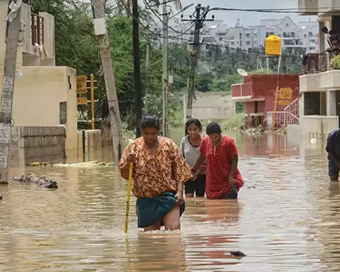 PM Modi visit USA
PM Modi visit USA Only the mirror in my washroom and phone gallery see the crazy me : Sara Khan
Only the mirror in my washroom and phone gallery see the crazy me : Sara Khan Karnataka rain fury: Photos of flooded streets, uprooted trees
Karnataka rain fury: Photos of flooded streets, uprooted trees Cannes 2022: Deepika Padukone stuns at the French Riviera in Sabyasachi outfit
Cannes 2022: Deepika Padukone stuns at the French Riviera in Sabyasachi outfit Ranbir Kapoor And Alia Bhatt's Wedding Pics - Sealed With A Kiss
Ranbir Kapoor And Alia Bhatt's Wedding Pics - Sealed With A Kiss Oscars 2022: Every Academy Award Winner
Oscars 2022: Every Academy Award Winner Shane Warne (1969-2022): Australian cricket legend's life in pictures
Shane Warne (1969-2022): Australian cricket legend's life in pictures Photos: What Russia's invasion of Ukraine looks like on the ground
Photos: What Russia's invasion of Ukraine looks like on the ground Lata Mangeshkar (1929-2022): A pictorial tribute to the 'Nightingale of India'
Lata Mangeshkar (1929-2022): A pictorial tribute to the 'Nightingale of India' PM Modi unveils 216-feet tall Statue of Equality in Hyderabad (PHOTOS)
PM Modi unveils 216-feet tall Statue of Equality in Hyderabad (PHOTOS)The Badminton Association of India (BAI) has announced a 14-member-strong India squad for
- Men’s Sr Hockey Nationals to be played in division-based format from April 4
- Mensik denies Djokovic 100th title in Miami final
- KIPG: Son of a vegetable vendor, Bihar’s Jhandu Kumar eyes Worlds, 2028 Paralympics
- Hardik Singh credits hard work and team unity for receiving HI Midfielder of the Year award
- Djokovic, Alcaraz land in same half of Miami draw
Air pollution second largest cause of deaths in Delhi, say experts Last Updated : 08 Mar 2017 07:02:03 PM IST 
(file photo)
The monster of air pollution is the second biggest killer in the National Capital Region (NCR), environmentalists have said here and asked people to combat and curb it.
Delhi and its surroundings are densely polluted, Professor Raj Kumar, head of the Pulmonary Medicine Department at the National Centre of Allergy, Asthma and Immunology (NCAAI), said at a seminar here organised by Director of Environment and Social Development Association (SEDA) Jitendra Nagar.
"In winter, the particulate matter (PM) 10 and PM 2.5 pass critical limits. The particulate matters contain hazardous elements of carbon monoxide, SO2, nitrous oxides and lead. Children and older persons are more vulnerable to its effects, which surface after 24 hours of exposure," Kumar said.
"The time periods between 6 a.m. to 10 a.m. and 5 p.m. to 10 p.m. are critical, during which the air emits the highly polluted elements," he added.
"Indoor air pollution, which is largely ignored, is also very hazardous to human beings," Kumar said.
"In fact, it has been found that indoor air pollution is the second largest factor for human death. Kitchens, especially in rural areas, are the main sources of indoor air pollution as meals are cooked on open fire. In urban areas also, coal is used in down-trodden sections of the society which generates carbon monoxide," he added.
Kumar said that with the ongoing state of affairs, Delhi is being termed as the 'asthma capital' of the world. He suggested that carpets should not be used as they contain pests and one cannot disinfect them despite dense cleaning.
Ganesh Hospital Managing Director Archana Sharma, who was a co-sponsor of the seminar, said that during the first three months of pregnancy, indoor air pollution affects the unborn child hazardously.
She demanded that the study of the environment should be included in medical education.
Chief Architect and Town Planner of Ghaziabad Development Authority (GDA) Ishtiyak Ahmad said that in view of the deteriorating air quality due to construction activities, the authority has increased financial penalty on violators of environment rules from the minimum of Rs 10,000 to Rs 5 lakh.
The seminar, conducted at the Institute of Management Technology here. Besides IMT students, was atteded by Ghaziabad Mayor Ashu Verma and Uttar Pradesh legislator from the city Suresh Bansal.
For Latest Updates Please-
Join us on
Follow us on








172.31.16.186







